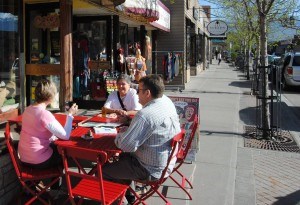
The results are in – the vast majority of residents and businesses thought last summer’s sidewalk seating pilot project was good for tourism and would like to see the program continue into the future.
Over a four-week period the municipality invited residents and businesses to provide feedback on last summer’s pilot project in order to gather information on how commercial use of public space could be regulated in town.
Two hundred and fifty three people filled out the online survey and one resident presented directly to council Feb. 16. The municipality also received 853 individual comments.
The results found that more than 70 per cent of respondents believe sidewalk seating was good for tourism and 67 per cent would like to see the program continue in future years.
Christine Nadon, communications manager for the municipality, presented the survey’s findings during a committee-of-the-whole meeting Feb. 23.
One of the main concerns raised by respondents was the effect sidewalk seating had on pedestrian traffic.
Charlie Finley, a long time resident, told council on Feb. 16 that pedestrians and cyclists should be given priority, particularly on Patricia Street which has narrower sidewalks.
“Connaught is a little better—it has wider sidewalks. But Patricia Street, as much as I love it, is a minefield,” he said, listing off the numerous obstacles already cluttering the sidewalks—sandwich boards, trees, benches, bike racks and garbage cans.
“I’d love to see it work,” he said, suggesting perhaps Jasper could take a page out of Banff’s book, using parking spots on the street for sidewalk seating thereby freeing up the sidewalk for pedestrians.
Finley wasn’t alone, several other respondents suggested similar ideas.
Another suggestion, which has been batted around for years, was to close Patricia Street to vehicles, making it a pedestrian only street.
Some respondents also raised concerns about the impact dining outdoors has on the town’s cleanliness, while others expressed mixed feelings about allowing dogs to dine with their owners.
There was also some concern about the appearance of sidewalk seating areas, with one respondent putting it bluntly: “Some patios were gorgeous, others tacky.”
Nadon also pointed out that some people felt businesses who benefited from an expanded business area should pay more taxes, but Mayor Richard Ireland was quick to point out that in order to participate in the pilot project restaurants were required to ensure there was an equal number of seats that were free inside the restaurant in case of bad weather.
“There was an exchange of area, but not a increased number of seats,” said Ireland.
On a positive note, respondents said sidewalk seating created a vibrant, lively and enjoyable atmosphere downtown and increased the sense of community and improved visitor experience. They also commended the municipality for being progressive and trying new things.
The municipality also surveyed the restauranteurs who participated in the pilot project, all of whom said they would like the program to continue in future years.
According to respondents the Jasper Brewing Company had the best outdoor seating area, followed by Papa George’s and Cassios Italian Restaurant.
Prior to last summer, restauranteurs had been requesting permission to set up sidewalk seating for years, but their requests were always denied because the municipality doesn’t have a bylaw governing commercial use of public land.
Administration is currently working on a bylaw to deal with these types of issues and presented its first draft to council at the Feb. 23 committee-of-the-whole meeting.
As well as sidewalk seating, the bylaw will also consider busking, commercial filming, farmer’s markets, special events, and mobile vendors.
The farmer’s market has been operating under its own pilot project for the past two years, allowing it to set up at the McCready Centre parking lot for its weekly summer markets.
During Culture Days last September, the municipality also held a two-day busking trial, but only 27 people responded during the public consultation period, which was deemed too small of a sample to make any concrete conclusions.
Paul Clarke and Nicole Veerman [email protected] or [email protected]
